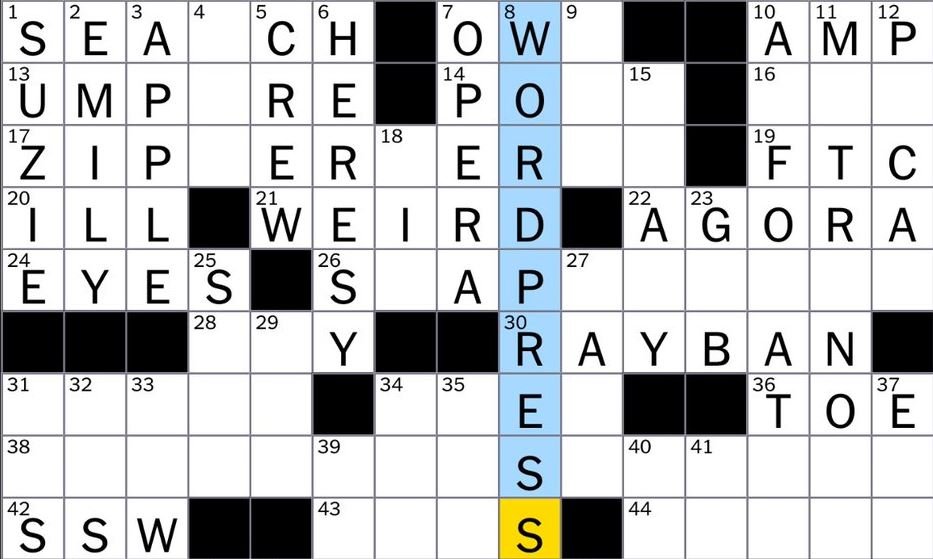Crossword puzzles have always been a source of entertainment, intellectual challenge, and a way to unwind for people of all ages. Among the many crosswords available, the New York Times (NYT) crossword puzzle has become one of the most iconic and widely recognized. Its blend of daily clues, clever wordplay, and varied difficulty levels offers a unique experience for puzzle enthusiasts worldwide. Whether you’re a seasoned solver or a beginner, “NYT crossword clues” play a central role in shaping your experience. In this article, we’ll break down some of the key features of the Sunday NYT crossword puzzle for April 7, exploring both the clues and the solutions to help you understand how to approach this puzzle and master it.
The Evolution of NYT Crossword Clues
The NYT crossword puzzle has undergone significant evolution since its debut in 1942. Created by Arthur Wynne and modified over the years, it has grown from a simple pastime to a daily intellectual pursuit. One of the most intriguing elements of this puzzle is the changing nature of the clues. For instance, the difficulty of the clues increases as the week progresses, with Sunday’s puzzle being the most challenging. On Sundays, the clues are often long and intricate and require a deep understanding of wordplay and culture to solve.
Unlike weekday puzzles, which feature standard grids, the Sunday puzzle is often larger, usually consisting of a 21×21 grid. It presents a considerable challenge not only in terms of size but also in the complexity of the clues. Solvers are tasked with deciphering these clues to find an answer that fits the given space. These clues could be related to wordplay, cultural references, current events, or puns, making the Sunday crossword puzzle an enjoyable yet challenging experience.
Understanding the Clue Structure
Understanding the clue structure is the first key to solving the NYT crossword clues. NYT crossword clues are typically divided into two types: straightforward clues and cryptic clues. The former are clues directly defining the answer, while the latter uses wordplay, indirect references, or misdirection to get to the solution. The most famous example of this clue is a “double definition” clue, where two definitions point to a single word.
For example, a typical straightforward clue might read: “Capital of France (5),” with the answer being “Paris.” On the other hand, a cryptic clue might read: “Let the cat out of the bag (5),” where the solution is “Reveal,” using wordplay that draws on the metaphorical meaning of “let the cat out of the bag.”
It’s also important to note that Sunday NYT crossword clues are known for their lengthy descriptions and often feature multi-word clues. These multi-word clues typically require the solver to think more creatively, sometimes requiring knowledge of pop culture, history, geography, or even literature. Some of the most challenging clues might also incorporate abbreviations or reversals, adding another layer of difficulty to the puzzle.
Tackling Sunday, April 7, 2025: A Sample of NYT Crossword Clues
Let’s explore a few sample clues from the NYT crossword puzzle for Sunday, April 7, 2025, to understand better the structure, variety, and difficulty that solvers might encounter:
- Clue: “Where you might find the Mona Lisa (6)”
- Solution: “Louvre”
- This is a straightforward clue, and the answer directly references a famous museum in Paris.
- Clue: “A type of jazz (4)”
- Solution: “Bebop”
- Here, the clue references a specific jazz genre, with “bebop” being a well-known style associated with improvisation.
- Clue: “She said, ‘I am the walrus’ (3).”
- Solution: “Ono”
- This cryptic clue references a famous line from John Lennon’s song “I Am the Walrus.” The answer is Yoko Ono, a renowned figure in the music world.
- Clue: “Unobtrusive, as a colour (5).”
- Solution: “Muted”
- This clue requires the solver to think about colour descriptions. “Muted” colours are typically softer and less bright.
- Clue: “Writers’ abbr. (3)”
- Solution: “Ed.”
- A simple abbreviation clue where “Ed.” stands for “Editor,” a common abbreviation in the publishing world.
These clues exemplify the straightforward and cryptic clues you will encounter in the Sunday crossword. As you can see, while some clues are relatively simple and direct, others require you to think about cultural references, word meanings, or even hidden puns. The key to success lies in breaking down the clues, identifying patterns, and recognizing standard crossword conventions.
Tips for Solving NYT Crossword Clues
Solving the Sunday crossword puzzle can be daunting if you’re a beginner. However, with the right strategies and a little practice, you can improve your problem-solving skills and enjoy the experience more. Here are some helpful tips for solving NYT crossword clues:
1. Start with the Easy Clues
It’s a good idea to begin solving with the clues that seem most effortless to you. Often, these are the short, straightforward clues that don’t require a lot of wordplay. Solving these first will help you fill in more letters and give you a solid foundation for tackling the more difficult clues later.
2. Focus on Crosswordese
Crosswordese refers to common words or abbreviations that frequently appear in puzzles. These include two- or three-letter words like “ER,” “IT,” and “OES.” Familiarizing yourself with these crossword staples can make solving much faster.
3. Think Outside the Box
Many NYT crossword clues involve wordplay and misdirection. If you’re stuck, try thinking outside the box. For example, clues pointing to an object might instead ask for a related word or concept. Be open to interpreting clues in multiple ways.
4. Don’t Overthink Cryptic Clues
Cryptic clues can be tricky, but they often follow patterns. The definition part of the clue will typically be at the beginning or the end. If you don’t understand the clue immediately, try breaking it down into smaller parts and consider the different meanings of the words used.
5. Use Cross-Checking
As you work through the puzzle, use cross-checking to confirm your answers. If you have a few letters in place, they can give you valuable hints for the adjacent clues. Sometimes, solving one clue will help you solve several others.
6. Take Breaks
If you find yourself stuck, don’t hesitate to take a break. Sometimes, stepping away from the puzzle for a few minutes or hours can help you approach it with a fresh perspective.
The Appeal of NYT Crossword Puzzles
The appeal of the NYT crossword puzzle is clear. It’s a game for the mind and a source of community. Many solvers engage with each other online or in-person to discuss clues, share strategies, and compare solutions. It’s a game that unites people who enjoy the challenge of word puzzles and appreciate the accomplishment of completing a particularly tricky puzzle.
Furthermore, the satisfaction derived from successfully solving an NYT crossword clue, especially a difficult or obscure one, is unique. The sense of joy and accomplishment isn’t just about filling in the grid; it’s about feeling like you’ve cracked a code, solved a mystery, or outsmarted a tricky clue.
Conclusion
The Sunday NYT crossword puzzle for April 7 is another example of the captivating experience these puzzles provide solvers. With clues ranging from straightforward to complex, it’s an engaging mental workout that challenges your vocabulary, cultural knowledge, and problem-solving skills. By understanding the different types of clues, applying proven solving techniques, and practising regularly, anyone can improve their crossword-solving abilities and find greater enjoyment in this timeless tradition. Whether you’re solving on your own or with friends, there’s no denying the thrill of cracking the “NYT crossword clues.” Happy solving!
Also, Read The Following: ecrypto1.com Crypto Security.












